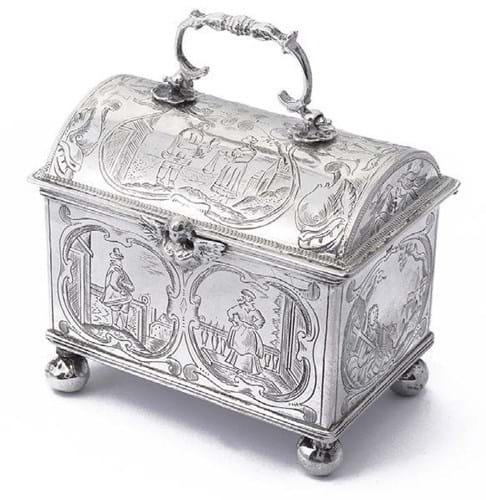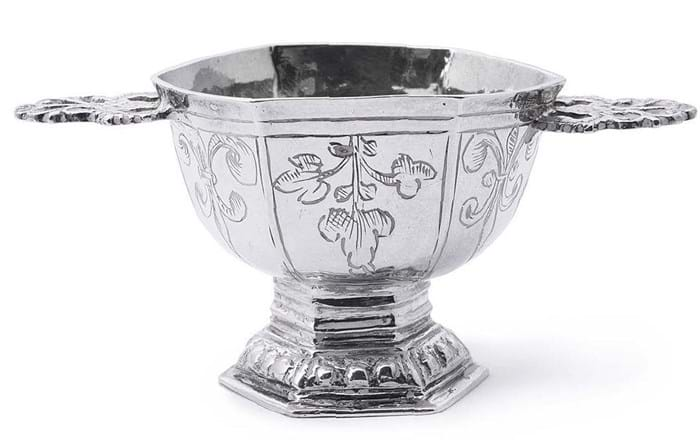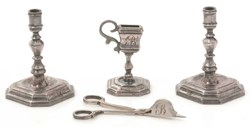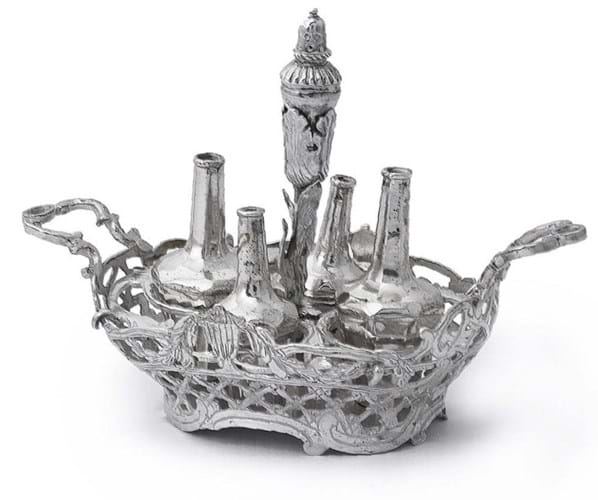
Large extensive collections have given way to smaller objects that are more easily displayed.
This is perhaps one of the attractions around collecting miniature wares or ‘toys’, be they in the form of porcelain scent bottles, scaled-down wooden furniture or silver smallwork. A miniature version can often make as much or more than the full-size model.

Two miniature beakers, both unmarked and thought to be probably 17th century in date. The example pictured left initialled FS which featured unusual decoration of scales half of which are engraved with zig zag motifs, sold for £3500 at Olympia Auctions. The example shown right engraved with more standard floral scrollwork 0-made £500.
That said, silver miniatures have been collectable for a long time. These small scale but often carefully crafted versions of domestic household items are thought to have variously served as toys for wealthy young girls, components for cabinets of curiosity or travellers’ samples and date back to the 17th century.
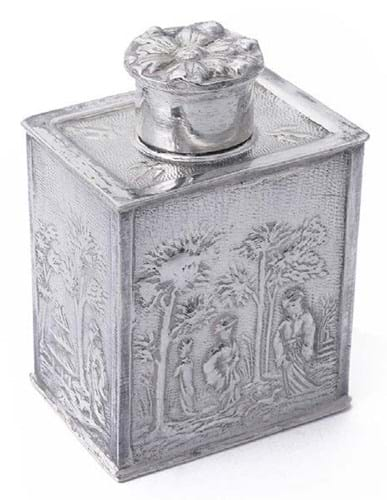
A 2in (4.8cm) tea caddy marked for Jan Breda and dated to c.1700, chased on a matted ground with chinoiserie scenes. It sold just under estimate at £650 at Olympia Auctions.
The Netherlands was a major centre for their manufacture with a number of goldsmiths’ dynasties who specialised in silver toys or miniatures in the 18th century such as the van Geffen, the van Strant and van Somerwil families. And the Dutch remain major collectors of these pieces.

A 1¾in (4.5cm) Dutch circular shaving dish marked for Johannes van Somerwil, Amsterdam 1759, sold for £380 at Olympia Auctions.
London collector
Olympia Auctions (25% buyer’s premium) in west London had a collection of around 65 to offer in its November 22 sale of European Objects and Works of Art.
They had been amassed by a London collector mainly between 1960-90, spanned items ranging in date from the 17th to the 19th centuries and included a number of pieces by those specialist Dutch silver miniature-making families.
There was enough critical mass here to generate some keen attention. With bidding online and via the phones the sale generated international interest and, while not everything found a buyer, the rarer and more unusual items were often pursued to levels way past the pre-sale guides. Those that did not sell or made lower prices tended to be the more common variants.
“I was delighted to see how strong the market is for real rarities with much interest in these from the Netherlands,” said the auction’s head of sale Matthew Barton.
The entire collection raised a hammer total just short of £51,000.

Two miniatures by the Amsterdam goldsmith Arnoldus van Geffen who was working between 1728-69, is regarded as one of the best-known specialist Dutch makers of miniature silver toys and whose mark is a distinctive hunting horn. The 1½in (4.2cm) wide foot warmer of 1766 fitted with a drawer and swinging turned handle, pierced to the cover, took £2000 at Olympia Auctions. The 2¾in (7cm) inkstand from 1738, fitted with a pen holder with quill, ink and pounce pot, sold for £1300.
Stranger things
The biggest money was paid out for the most unusual forms.
Selling for £13,000 to top the list, a multiple of its £1200-1800 guide, was a mid-18th century 3½in (9cm) wide miniature openwork pierced and engraved basket fitted with a bottle frame and four bottles in two different sizes, a rare intact survival. The finial of the basket also served as a detachable sugar caster. This was marked for Jan Diederik Pont of Amsterdam, 1755.
Another of the top sellers was a 3in (7.5cm) wide marriage casket, unmarked except for later control marks but dated 1748 alongside an inscription.
Full-scale marriage caskets derived from the tradition of the knottekistje, where a prospective suitor would offer coins wrapped in cloth with a knot, to entice his intended bride. If the offer was acceptable, she would pull the knot tighter to indicate her consent to proceed with marriage.
As wealth increased the cloth was replaced by a decorative textile cloth, which later became a silver casket. This then became a symbol of engagement representing the romantic idea of giving your heart to another.
This small-scale model was finely and profusely engraved in detail on all sides: the lid with figures emblematic of marriage with vignettes of figures in interiors and landscapes to the sides and pairs of figures surrounded by scrolls and animals to the domed lid.
An inscription to the underside reading Dit heeft Fietke/Hiddes tot een Gedagtenis/aen Laes Jans gegewen alludes to it being made in special memory of two betrothed people. It sold for £5000 against a guide of £2000-3000.
A 2¼in (5.7cm) high curve fronted water cistern with similar stand featuring a distinctive pierced cresting and a scroll engraved reservoir was another high flyer. It had a maker’s mark only of a fleur de lys and was catalogued as possibly 18th century. Estimated at £250-350, it took £4000.
Rather more, £3000-4000, had been expected for another unusual piece: a miniature chandelier marked for Jan Bonket, a well-known Amsterdam goldsmith, and dated to c.1770. This piece, just over 4¼in (11cm) high, was worked with no fewer than 24 miniature lights on five scrolling arms complete with drip pans. It sold for £4200.
A more modest form of miniature lighting, a 2¾in (7.3cm) high wall sconce of the type that would have featured in many a Dutch middle-class home in full-size form, was marked for the specialist miniature maker Frederick van Strant I and dated to c.1720. This made £1800.
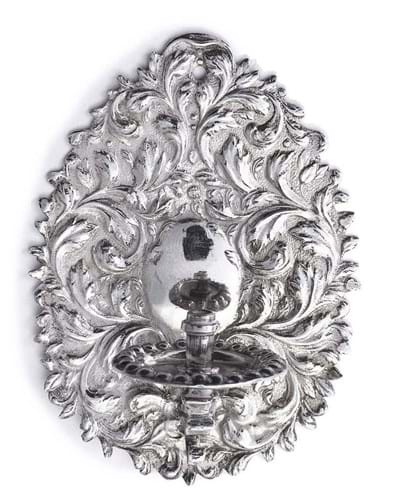
Dutch wall sconce marked for the specialist miniature maker Frederick van Strant I, sold for £1800 at Olympia Auctions.
Domestic bliss
Domestic utensils, of which there were many here, included a 2¼in (6cm) hexagonal brandy bowl, unmarked, but thought to be probably 18th century, decorated with engraved panels of foliage and strapwork, and a 1½in (4cm) high tapering miniature beaker, unmarked but probably 17th century in date, engraved with scales with zig-zags and bearing the initials FS and a dolphin tax mark.
The brandy bowl realised £1900 and the miniature beaker £3500.
These and other examples are pictured here.


